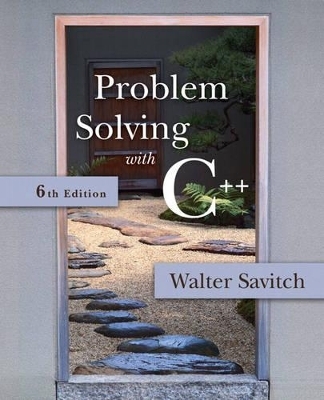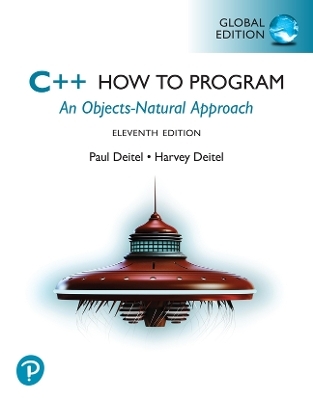
Problem Solving with C++
Pearson
978-0-321-41269-0 (ISBN)
- Titel erscheint in neuer Auflage
- Artikel merken
Chapter 1 Introduction to Computers and C++ Programming
1.1 COMPUTER SYSTEMS
Hardware
Software
High-Level Languages
Compilers
History Note
1.2 PROGRAMMING AND PROBLEM-SOLVING
Algorithms
Program Design
Object-Oriented Programming
The Software Life Cycle
1.3 INTRODUCTION TO C++
Origins of the C++ Language
A Sample C++ Program
Pitfall:Using the Wrong Slash in /n
Programming Tip: Input and Output Syntax
Layout of a Simple C++ Program
Pitfall: Putting a Space before the include File Name
Compiling and Running a C++ Program
Programming Tip: Getting Your Program to Run
1.4 TESTING AND DEBUGGING
Kinds of Program Errors
Pitfall: Assuming Your Program Is Correct
Chapter Summary 32
Chapter 2 C++ Basics
2.1 VARIABLES AND ASSIGNMENTS
Variables
Names: Identifiers
Variable Declarations
Assignment Statements
Pitfall: Uninitialized Variables
Programming Tip: Use Meaningful Names
2.2 INPUT AND OUTPUT
Output Using cout
Include Directives and Namespaces
Escape Sequences
Programming Tip: End Each Program with a /n or endl
Formatting for Numbers with a Decimal Point
Input Using cin
Designing Input and Output
Programming Tip: Line Breaks in I/O
2.3 DATA TYPES AND EXPRESSIONS
The Types int and double
Other Number Types
The Type char
The Type bool
Introduction to the Class string
Type Compatibilities
Arithmetic Operators and Expressions
Pitfall: Whole Numbers in Division
More Assignment Statements
2.4 SIMPLE FLOW OF CONTROL
A Simple Branching Mechanism
Pitfall: Strings of Inequalities
Pitfall: Using = in place of ==
Compound Statements
Simple Loop Mechanisms
Increment and Decrement Operators
Programming Example: Charge Card Balance
Pitfall: Infinite Loops
2.5 PROGRAM STYLE
Indenting
Comments
Naming Constants
Chapter 3 More Flow of Control
3.1 USING BOOLEAN EXPRESSIONS
Evaluating Boolean Expressions
Pitfall: Boolean Expressions Convert to int Values
Enumeration Types (Optional)
3.2 MULTIWAY BRANCHES
Nested Statements
Programming Tip: Use Braces in Nested Statements
Multiway if-else Statements
Programming Example: State Income Tax
The switch Statement
Pitfall: Forgetting a break in a switch Statement
Using switch Statements for Menus
Blocks
Pitfall: Inadvertent Local Variables
3.3 MORE ABOUT C++ LOOP STATEMENTS
The while Statements Reviewed
Increment and Decrement Operators Revisited
The for Statement
Pitfall: Extra Semicolon in a for Statement
What Kind of Loop to Use
Pitfall: Uninitialized Variables and Infinite Loops
The break Statement
Pitfall: The break Statement in Nested Loops
3.4 DESIGNING LOOPS
Loops for Sums and Products
Ending a Loop
Nested Loops
Debugging Loops
Chapter 4 Procedural Abstraction and Functions That Return a Value
4.1 TOP-DOWN DESIGN
4.2 PREDEFINED FUNCTIONS
Using Predefined Functions
Type Casting
Older Form of Type Casting
Pitfall: Integer Division Drops the Fractional Part
4.3 PROGRAMMER-DEFINED FUNCTIONS
Function Definitions
Functions That Return a Boolean Value
Alternate Form for Function Declarations
Pitfall: Arguments in the Wrong Order
Function Definition—Syntax Summary
More About Placement of Function Definitions
Programming Tip: Use Function Calls in Branching Statements
4.4 PROCEDURAL ABSTRACTION
The Black Box Analogy
Programming Tip: Choosing Formal Parameter Names
Programming Tip: Nested Loops
Case Study: Buying Pizza
Programming Tip: Use Pseudocode
4.5 LOCAL VARIABLES
The Small Program Analogy
Programming Example: Experimental Pea Patch
Global Constants and Global Variables
Call-by-Value Formal Parameters Are Local Variables
Namespaces Revisited
Programming Example: The Factorial Function
4.6 OVERLOADING FUNCTION NAMES
Introduction to Overloading
Programming Example: Revised Pizza-Buying Program
Automatic Type Conversion
Chapter 5 Functions for All Subtasks
5.1 void FUNCTIONS
Definitions of void Functions
Programming Example: Converting Temperatures
return Statements in void Functions
5.2 CALL-BY-REFERENCE PARAMETERS
A First View of Call-by-Reference
Call-by-Reference in Detail
Programming Example: The swap_values Function
Mixed Parameter Lists
Programming Tip: What Kind of Parameter to Use
Pitfall: Inadvertent Local Variables
5.3 USING PROCEDURAL ABSTRACTION
Functions Calling Functions
Preconditions and Postconditions
Case Study: Supermarket Pricing
5.4 TESTING AND DEBUGGING FUNCTIONS
Stubs and Drivers
5.5 GENERAL DEBUGGING TECHNIQUES
Keep an Open Mind
Check Common Errors
Localize the Error
The assert macro
Chapter 6 I/O Streams as an Introduction to Objects and Classes
6.1 STREAMS AND BASIC FILE I/O
Why Use Files for I/O?
File I/O
Introduction to Classes and Objects
Programming Tip: Check Whether a File Was Opened Successfully
Techniques for File I/O
Appending to a File (Optional)
File Names as Input (Optional)
6.2 TOOLS FOR STREAM I/O
Formatting Output with Stream Functions
Manipulators
Streams as Arguments to Functions
Programming Tip: Checking for the End of a File
A Note on Namespaces
Programming Example: Cleaning Up a File Format
6.3 CHARACTER I/O
The Member Functions get and put
The putback Member Function (Optional)
Programming Example: Checking Input
Pitfall: Unexpected '/n' in Input
The eof Member Function
Programming Example: Editing a Text File
Predefined Character Functions
Pitfall: toupper and tolower Return Values
6.4 INHERITANCE
Inheritance Among Stream Classes
Programming Example: Another new_line Function
Default Arguments for Functions (Optional)
Chapter 7 Arrays
7.1 INTRODUCTION TO ARRAYS
Declaring and Referencing Arrays
Programming Tip: Use for Loops with Arrays
Pitfall: Array Indexes Always Start with Zero
Programming Tip: Use a Defined Constant for the Size of an Array
Arrays in Memory
Pitfall: Array Index Out of Range
Initializing Arrays
7.2 ARRAYS IN FUNCTIONS
Indexed Variables as Function Arguments
Entire Arrays as Function Arguments
Pitfall: Inconsistent Use of const Parameters
Functions That Return an Array
Case Study: Production Graph
7.3 PROGRAMMING WITH ARRAYS
Partially Filled Arrays
Programming Tip: Do Not Skimp on Formal Parameters
Programming Example: Searching an Array
Programming Example: Sorting an Array
7.4 MULTIDIMENSIONAL ARRAYS
Multidimensional Array Basics
Multidimensional Array Parameters
Programming Example: Two-Dimensional Grading Program
Pitfall: Using Commas Between Array Indexes
Chapter 8 Strings and Vectors
8.1 AN ARRAY TYPE FOR STRINGS
C-String Values and C-String Variables
Pitfall: Using = and == with C Strings
Other Functions in
C-String Input and Output
C-String-to-Number Conversions and Robust Input
8.2 THE STANDARD string CLASS
Introduction to the Standard Class string
I/O with the Class string
Programming Tip: More Versions of getline
Pitfall: Mixing cin >> variable; and getline
String Processing with the Class string
Programming Example: Palindrome Testing
Converting between string Objects and C Strings
8.3 VECTORS
Vector Basics
Pitfall: Using Square Brackets Beyond the Vector Size
Programming Tip: Vector Assignment Is Well Behaved
Efficiency Issues
Chapter 9 Pointers and Dynamic Arrays
9.1 POINTERS
Pointer Variables
Basic Memory Management
Pitfall: Dangling Pointers
Static Variables and Automatic Variables
Programming Tip: Define Pointer Types
9.2 DYNAMIC ARRAYS
Array Variables and Pointer Variables
Creating and Using Dynamic Arrays
Pointer Arithmetic (Optional)
Multidimensional Dynamic Arrays (Optional)
Chapter 10 Defining Classes
10.1 STRUCTURES
Structures for Diverse Data
Pitfall: Forgetting a Semicolon in a Structure Definition
Structures as Function Arguments
Programming Tip: Use Hierarchical Structures
Initializing Structures
10.2 CLASSES
Defining Classes and Member Functions
Public and Private Members
Programming Tip: Make All Member Variables Private
Programming Tip: Define Accessor and Mutator Functions
Programming Tip: Use the Assignment Operator with Objects
Programming Example: BankAccount Class–Version 1
Summary of Some Properties of Classes
Constructors for Initialization
Programming Tip: Always Include a Default Constructor
Pitfall: Constructors with No Arguments
10.3 ABSTRACT DATA TYPES
Classes to Produce Abstract Data Types
Programming Example: Alternative Implementation of a Class
Chapter 11 Friends, Overloaded Operators, and Arrays in Classes
11.1 FRIEND FUNCTIONS
Programming Example: An Equality Function
Friend Functions
Programming Tip: Define Both Accessor Functions and Friend Functions
Programming Tip: Use Both Member and Nonmember Functions
Programming Example: Money Class (Version 1)
Implementation of digit_to_int (Optional)
Pitfall: Leading Zeros in Number Constants
The const Parameter Modifier
Pitfall: Inconsistent Use of const
11.2 OVERLOADING OPERATORS
Overloading Operators
Constructors for Automatic Type Conversion
Overloading Unary Operators
Overloading >> and <<
11.3 ARRAYS AND CLASSES
Arrays of Classes
Arrays as Class Members
Programming Example: A Class for a Partially Filled Array
11.4 CLASSES AND DYNAMIC ARRAYS
Programming Example: A String Variable Class
Destructors
Pitfall: Pointers as Call-by-Value Parameters
Copy Constructors
Overloading the Assignment Operator
Chapter 12 Separate Compilation and Namespaces
12.1 SEPARATE COMPILATION
ADTs Reviewed
Case Study: DigitalTime–A Class Compiled Separately
Using #ifndef
Programming Tip: Defining Other Libraries
12.2 NAMESPACES
Namespaces and using Directives
Creating a Namespace
Qualifying Names
A Subtle Point About Namespaces (Optional)
Unnamed Namespaces
Programming Tip: Choosing a Name for a Namespace
Pitfall:Confusing the Global Namespace and the Unnamed Namespace
Chapter 13 Pointers and Linked Lists
13.1 NODES AND LINKED LISTS
Nodes
Linked Lists
Inserting a Node at the Head of a List
Pitfall: Losing Nodes
Searching a Linked List
Pointers as Iterators
Inserting and Removing Nodes Inside a List
Pitfall: Using the Assignment Operator with Dynamic Data Structures
Variations on Linked Lists
Linked Lists of Classes
13.2 STACKS AND QUEUES
Stacks
Programming Example: A Stack Class
Queues
Programming Example: A Queue Class
Chapter 14 Recursion
14.1 RECURSIVE FUNCTIONS FOR TASKS
Case Study: Vertical Numbers
A Closer Look at Recursion
Pitfall: Infinite Recursion
Stacks for Recursion
Pitfall: Stack Overflow
Recursion Versus Iteration
14.2 RECURSIVE FUNCTIONS FOR VALUES
General Form for a Recursive Function That Returns a Value
Programming Example: Another Powers Function
14.3 THINKING RECURSIVELY
Recursive Design Techniques
Case Study: Binary Search–An Example of Recursive Thinking
Programming Example: A Recursive Member Function
Chapter 15 Inheritance
15.1 INHERITANCE BASICS
Derived Classes
Constructors in Derived Classes
Pitfall: Use of Private Member Variables from the Base Class
Pitfall: Private Member Functions Are Effectively Not Inherited
The protected Qualifier
Redefinition of Member Functions
Redefining Versus Overloading
Access to a Redefined Base Function
15.2 INHERITANCE DETAILS
Functions That Are Not Inherited
Assignment Operators and Copy Constructors in Derived Classes
Destructors in Derived Classes
15.3 POLYMORPHISM
Late Binding
Virtual Functions in C++
Virtual Functions and Extended Type Compatibility
Pitfall: The Slicing Problem
Pitfall: Not Using Virtual Member Functions
Pitfall: Attempting to Compile Class Definitions Without Definitions for Every Virtual Member Function
Programming Tip: Make Destructors Virtual
Chapter 16 Exception Handling
16.1 EXCEPTION-HANDLING BASICS
A Toy Example of Exception Handling
Defining Your Own Exception Classes
Multiple Throws and Catches
Pitfall: Catch the More Specific Exception First
Programming Tip: Exception Classes Can Be Trivial
Throwing an Exception in a Function
Exception Specification
Pitfall: Exception Specification in Derived Classes
16.2 PROGRAMMING TECHNIQUES FOR EXCEPTION HANDLING
When to Throw an Exception
Pitfall: Uncaught Exceptions
Pitfall: Nested try-catch Blocks
Pitfall: Overuse of Exceptions
Exception Class Hierarchies
Testing for Available Memory
Rethrowing an Exception
Chapter 17 Templates
17.1 TEMPLATES FOR ALGORITHM ABSTRACTION
Templates for Functions
Pitfall: Compiler Complications
Programming Example: A Generic Sorting Function
Programming Tip: How to Define Templates
Pitfall: Using a Template with an Inappropriate Type
17.2 TEMPLATES FOR DATA ABSTRACTION
Syntax for Class Templates
Programming Example: An Array Class
Chapter 18 Standard Template Library
18.1 ITERATORS
Using Declarations
Iterator Basics
Kinds of Iterators
Constant and Mutable Iterators
Reverse Iterators
Pitfall: Compiler Problems
Other Kinds of Iterators
18.2 CONTAINERS
Sequential Containers
Pitfall: Iterators and Removing Elements
Programming Tip: Type Definitions in Containers
Container Adapters stack and queue
Associative Containers set and map
Efficiency
18.3 GENERIC ALGORITHMS
Running Times and Big-O Notation
Container Access Running Times
Nonmodifying Sequence Algorithms
Container Modifying Algorithms
Set Algorithms
Sorting Algorithms
APPENDICES
1 C++ Keywords
2 Precedence of Operators
3 The ASCII Character Set
4 Some Library Functions
5 Inline Functions
6 Overloading the Array Index Square Brackets
7 The this Pointer
8 Overloading Operators as Member Operators
INDEX
| Erscheint lt. Verlag | 7.4.2006 |
|---|---|
| Sprache | englisch |
| Maße | 187 x 231 mm |
| Gewicht | 879 g |
| Themenwelt | Mathematik / Informatik ► Informatik ► Programmiersprachen / -werkzeuge |
| ISBN-10 | 0-321-41269-9 / 0321412699 |
| ISBN-13 | 978-0-321-41269-0 / 9780321412690 |
| Zustand | Neuware |
| Informationen gemäß Produktsicherheitsverordnung (GPSR) | |
| Haben Sie eine Frage zum Produkt? |
aus dem Bereich

